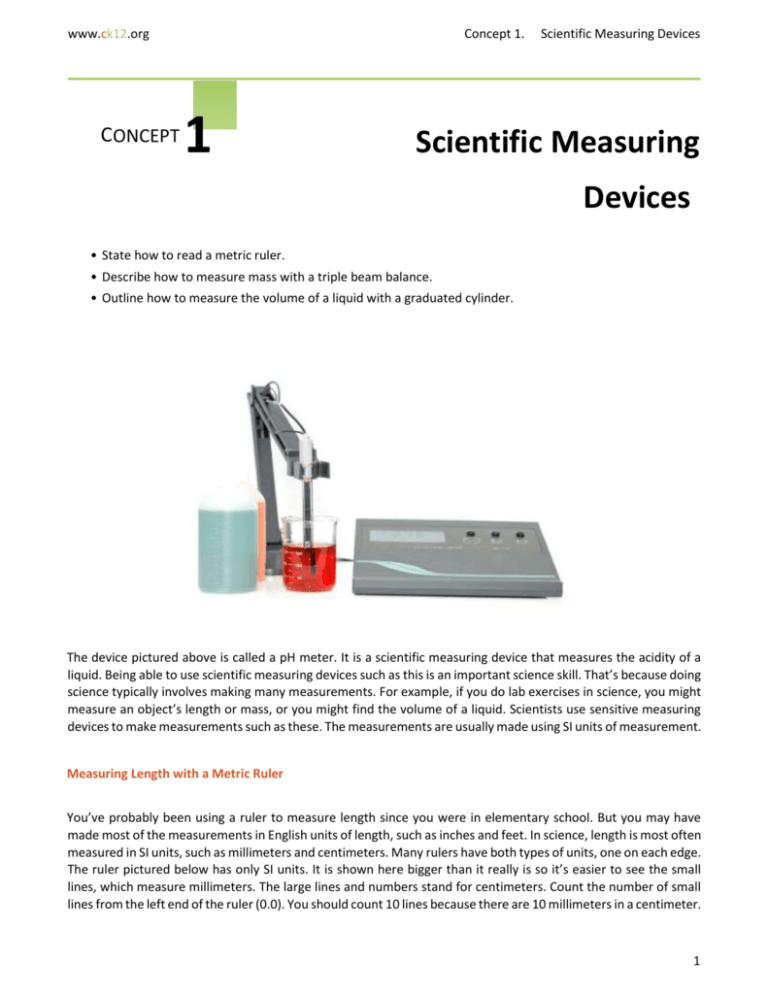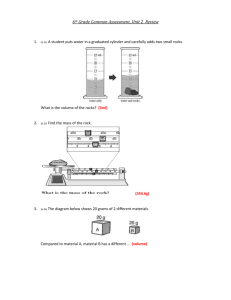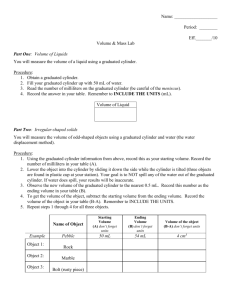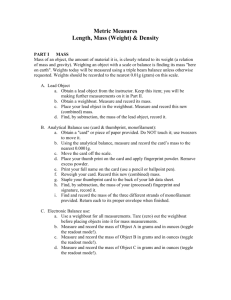Measuring Mass with a Balance
advertisement

www.ck12.org CONCEPT Concept 1. 1 Scientific Measuring Devices Scientific Measuring Devices • State how to read a metric ruler. • Describe how to measure mass with a triple beam balance. • Outline how to measure the volume of a liquid with a graduated cylinder. The device pictured above is called a pH meter. It is a scientific measuring device that measures the acidity of a liquid. Being able to use scientific measuring devices such as this is an important science skill. That’s because doing science typically involves making many measurements. For example, if you do lab exercises in science, you might measure an object’s length or mass, or you might find the volume of a liquid. Scientists use sensitive measuring devices to make measurements such as these. The measurements are usually made using SI units of measurement. Measuring Length with a Metric Ruler You’ve probably been using a ruler to measure length since you were in elementary school. But you may have made most of the measurements in English units of length, such as inches and feet. In science, length is most often measured in SI units, such as millimeters and centimeters. Many rulers have both types of units, one on each edge. The ruler pictured below has only SI units. It is shown here bigger than it really is so it’s easier to see the small lines, which measure millimeters. The large lines and numbers stand for centimeters. Count the number of small lines from the left end of the ruler (0.0). You should count 10 lines because there are 10 millimeters in a centimeter. 1 www.ck12.org Q: What is the length in millimeters of the red line above the metric ruler? A: The length of the red line is 32 mm. Q: What is the length of the red line in centimeters? A: The length of the red line is 3.2 cm. Measuring Mass with a Balance Mass is the amount of matter in an object. Scientists often measure mass with a balance. A type of balance called a triple beam balance is pictured in Figure 1.1. To use this type of balance, follow these steps: 1. Place the object to be measured on the pan at the left side of the balance. 2. Slide the movable masses to the right until the right end of the arm is level with the balance mark. Start by moving the larger masses and then fine tune the measurement by moving the smaller masses as needed. 3. Read the three scales to determine the values of the masses that were moved to the right. Their combined mass is equal to the mass of the object. FIGURE 1.1 The Figure 1.2 is an enlarged version of the scales of the triple beam balance in Figure 1.1. It allows you to read the scales. The middle scale, which measures the largest movable mass, reads 300 grams. This is followed by the top scale, which reads 30 grams. The bottom scale reads 5.1 grams. Therefore, the mass of the object in the pan is 335.1 grams (300 grams + 30 grams + 5.1 grams). 2 www.ck12.org Concept 1. Scientific Measuring Devices Q: What is the maximum mass this triple beam balance can measure? A: The maximum mass it can measure is 610 grams (500 grams + 100 grams + 10 grams). Q: What is the smallest mass this triple beam balance can measure? A: The smallest mass it can measure is one-tenth (0.1) of a gram. To measure very small masses, scientists use electronic balances, like the one in the Figure 1.3. This type of balance also makes it easier to make accurate measurements because mass is shown as a digital readout. In the picture below, the balance is being used to measure the mass of a yellow powder on a glass dish. The mass of the dish alone would FIGURE 1.2 have to be measured first and then subtracted from the mass of the dish and powder together. The difference between the two masses is the mass of the powder alone. FIGURE 1.3 3 www.ck12.org Measuring Volume with a Graduated Cylinder At home, you might measure the volume of a liquid with a measuring cup. In science, the volume of a liquid might be measured with a graduated cylinder, like the one sketched in the Figure 1.4. The cylinder in the picture has a scale in milliliters (mL), with a maximum volume of 100 mL. Follow these steps when using a graduated cylinder to measure the volume of a liquid: 1. Place the cylinder on a level surface before adding the liquid. 2. After adding the liquid, move so your eyes are at the same level as the top of the liquid in the cylinder. 3. Read the mark on the glass that is at the lowest point of the curved surface of the liquid. This is called the meniscus. Q: What is the volume of the liquid in the graduated cylinder pictured above? FIGURE 1.4 A: The volume of the liquid is 67 mL. Q: What would the measurement be if you read the highest point of the curved surface of the liquid by mistake? A: The measurement would be 68 mL. Summary • In science, length may be measured with a metric ruler using SI units such as millimeters and centimeters. • Scientists measure mass with a balance, such as a triple beam balance or electronic balance. • In science, the volume of a liquid might be measured with a graduated cylinder. 4 www.ck12.org Concept 1. Scientific Measuring Devices Practice A micrometer is a measuring device that is used to make precise measurements of very small distances. At the URL below, read about the parts of a micrometer and how to use it. Then test your skills by reading a virtual micrometer. Be sure to check your answers at the bottom of the test page. If you need more practice, click on the “Try more” link below the answers. http://feh.eng.ohio-state.edu/tutorials/micrometer/micindex.html Review 1. Using the enlarged metric ruler segment shown below, what is the length of the blue line in centimeters? 2. Assume that an object has been placed in the pan of a triple beam balance. The scales of the balance are shown below. What is the mass of the object? 5 www.ck12.org 3. How much liquid does this graduated cylinder contain? References 1. Shannan Muskopf, modified by CK-12 Foundation - Peter Lai. . CC-BY-NC 2.0 6 www.ck12.org Concept 1. Scientific Measuring Devices 2. Shannan Muskopf, modified by CK-12 Foundation - Peter Lai. . CC-BY-NC 2.0 3. Image copyright Radu Razvan, 2012. . Used under license from Shutterstock.com 4. CK-12 Foundation. . CC-BY-NC-SA 3.0 7








